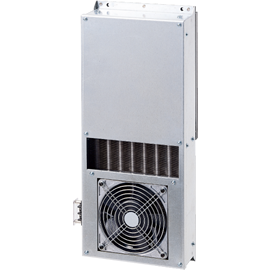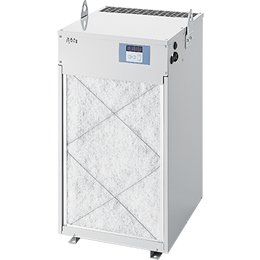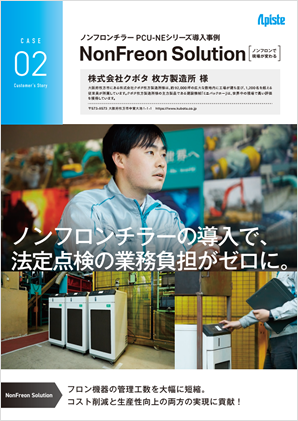Technical Information
1-1. Why use water for cooling?
This article explains why water is an excellent cooling medium, including related phenomena.
There are many things around us that use water for cooling purposes.
When you get burned, you cool the area with running water. Air conditioning in buildings and large commercial facilities also uses water as a medium.
Water is also used for cooling in many other situations.


Water is an excellent cooling medium
The reason why water is used for cooling in all sorts of situations is that, in addition to being an easy substance to obtain, its properties make it an excellent cooling medium.
- Chemically stable
Water is a substance that does not decompose into different substances when heated at room environment, and there is little risk of it significantly corroding other substances.
- High specific heat
Specific heat is the amount of heat required to raise the temperature of 1g of a substance by 1°C (K).
The unit used is kJ/(kg・℃).
Specific heat indicates the "degree of resistance to temperature change of a substance." The higher the specific heat of a substance, the more difficult it is to heat up or cool down.
High specific heat = A lot of heat is needed to raise the temperature of water
This means that, for example, if you pour water on a fire, it can remove a lot of heat from the burning material before the water temperature rises and boils.
As you can see from the table below, when comparing air and water, water has a specific heat capacity that is more than four times greater than that of air.
Let's apply this to cooling. For example, if you need 1 kg of water to lower 1 kg of water by 1 degree Celsius, then to achieve the same cooling with air,
1kg × 4.18 / 1.01 = 4.14kg
This is necessary. If we convert this to volume,
Water: 1L
Air: 3436L (3.5m3)
Considering that cooling with water requires only 1L to achieve the same amount of cooling that would require 3.5m3 of air, water is more efficient at cooling than air.
Water also has a high specific heat capacity compared to other liquids, and is known to have the highest specific heat capacity of any liquid substance at room temperature.Substance name Specific heat [kJ/kg・℃] / 20℃ air 1.01 water 4.18 ethanol 2.42 mineral oil 1.85 ethylene glycol 2.38 Because of these properties, water is often used for cooling purposes.
- Large heat of evaporation
Heat of vaporization is the heat required to change a liquid into a gas. Heat of vaporization is a type of latent heat, also known as latent heat of vaporization. As you can see from the table below, the heat of vaporization of water is significantly higher than that of other substances.
Substance name Boiling point [℃] Heat of evaporation [kJ/kg] water 100 2250 ethanol 80 393 mercury 357 285 liquid oxygen -183 213 liquid nitrogen -196 199 The greater the heat of evaporation, the more heat is required for evaporation, so it is said to be difficult to evaporate. Conversely, the greater the heat of evaporation, the more heat a substance takes from its surroundings when evaporating, so it can be said to have a greater cooling capacity. This principle is also used to make sprinkling water on a veranda in the summer evening feel cooler.
Another cooling facility that utilizes this principle in commerce and industry is the cooling tower. A cooling tower is a cooling device used to cool industrial water and freezers in building air conditioning and district heating and cooling systems. The cooling water comes into direct contact with outside air, causing some of the cooling water to evaporate, cooling the remaining water. At room temperature, the latent heat of evaporation of water is approximately 2,250 kJ/kg, and the specific heat is 4.2 kJ/kg・℃, so the evaporation of 1% of the cooling water will lower the temperature of the remaining water by approximately 6℃.
Related Column: Why is Kyoto so hot in the summer?
When it comes to summer events in Kyoto, the Gion Festival and the Gozan no Okuribi (Daimonji Fire) are famous. Although it is filled with many tourists every year, Kyoto is also known for its hot summers and bitterly cold winters. The average temperature in Kyoto in August in 2017 was 28.7°C. This is lower than the 25.6°C of Choshi, Chiba Prefecture, which is located at almost the same latitude.3.1℃ higherOn the other hand, the average temperature in January is 4.8℃ in Kyoto and 7.0℃ in Choshi.2.2℃ lower(Japan Meteorological Agency, 2017 (monthly values) temperature). But why is there such a big difference?
Here too, the properties of water come into play.
In addition to its density, water is also characterized by its specific heat capacity, i.e., the amount of heat required to raise the temperature of 1 g of a substance by 1°C. The specific heat capacity of water is extremely large compared to other substances.
For example, the specific heat capacity of water, 4.18 kJ/kg·°C, is about 1.7 times the specific heat capacity of ethanol, 2.42 kJ/kg·°C, and about 9 times the specific heat capacity of iron, 0.46 kJ/kg·°C.
It is often said that "water is hard to heat and hard to cool," but this is because water has a large specific heat capacity, so it requires a large amount of heat to heat it, but once it is heated, it can store a certain amount of heat.
A water-cooled engine uses the large specific heat capacity of water to cool the engine with water (or an aqueous solution of antifreeze).
A person's body temperature does not rise suddenly even in the hot summer, and it does not rise immediately even when they exercise because more than 60 percent of the body is water.
In addition, the heat of vaporization of water is 2,257 kJ x kg-1, which is nearly three times that of ethanol (838 kJ x kg-1). When a person sweats and the sweat evaporates, it takes away this large heat of vaporization, allowing the person to regulate their body temperature.
Furthermore, when ice melts, it absorbs a large amount of heat of fusion, 334 kJ x kg-1, from its surroundings. Conversely, when it freezes, it releases the same amount of heat of solidification. When ice is placed in water, the water cools because the ice absorbs heat of fusion as it melts. This value is 80 times the specific heat capacity of the same amount of water.
In early spring, tea fields are sometimes watered at night. This is because the heat of solidification released when the water on the tea freezes keeps the tea buds at around 0°C, preventing them from being damaged by frost if the temperature drops below freezing.
In areas surrounded by the sea on three sides, such as Choshi in Chiba Prefecture, the large amount of water in the sea helps to moderate temperature changes, so the temperature difference between winter and summer is relatively small.
However, in an inland basin without a sea like Kyoto, once the land is warmed by the sun's heat in the summer, it becomes very hot because the heat does not escape to the sea, and even if it cools down in the winter, it becomes cold because there is no heat supply from the sea.
Even though the two cities are located at the same latitude, the water situation is very different, which affects the annual temperature.
Source: Based on "Chapter 1: The Properties and Roles of Water 1-2: Why is Kyoto so hot in the summer?" (Ministry of Education, Culture, Sports, Science and Technology)
(http://www.mext.go.jp/b_menu/shingi/gijyutu/gijyutu0/shiryo/attach/1331537.htm)
Next item: 1-2. Fluorine-based inert liquid
People who viewed this page also checked out these documents:
Inquiry
For product inquiries, quote requests, etc.
Please feel free to contact us.










![Case study of the PCU-NE series of HFC alternative chillers [HFC alternative changes the workplace]](/files/user/images/common/bnr_case-pcu-ne.png)


